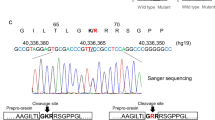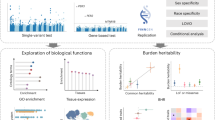Abstract
Essential hypersomnia (EHS) exhibits excessive daytime sleepiness without cataplexy and is associated with the HLA-DRB1*1501-DQB1*0602 haplotype, similar to narcolepsy with cataplexy. Single-nucleotide polymorphism (SNP) rs1154155 located in the T-cell receptor α (TCRA) locus has been recently identified as a novel genetic marker of susceptibility for narcolepsy with cataplexy. We investigated whether the SNP was associated with EHS in the Japanese population. We found a significant association with EHS patients possessing the HLA-DRB1*1501-DQB1*0602 haplotype, compared with HLA-matched healthy individuals (Pallele=0.008; Ppositivity=5 × 10−4), whereas no significant association was observed for EHS patients without this haplotype. Thus, TCRA is a plausible candidate for susceptibility to EHS patients positive for the HLA-DRB1*1501-DQB1*0602 haplotype.
Similar content being viewed by others
Introduction
Earlier studies have revealed that narcolepsy with cataplexy is associated with the human leukocyte antigen (HLA) and T-cell receptor α (TCRA) genes. With regard to HLA, almost all narcoleptic patients with cataplexy in Japan carry the HLA-DRB1*1501-DQB1*0602 haplotype.1, 2 Similar findings have been confirmed in narcoleptic patients of European and African decent, for whom the association is with DQB1*0602.2, 3 It has recently been reported that single-nucleotide polymorphism (SNP) rs1154155 located in the TCRA locus was associated with narcolepsy with cataplexy by means of a genome-wide association study in European populations, and this association was replicated in Asian populations.4 These findings suggest that immunological pathogenesis contributes to the development of narcolepsy with cataplexy.
Central nervous system (CNS) hypersomnias other than narcolepsy with cataplexy are also complex disorders. Both genetic and environmental factors are believed to contribute to the development of CNS hypersomnias, as is the case with narcolepsy with cataplexy.5, 6 Several reports have also confirmed the association between some CNS hypersomnias and HLA. About 30–50% of Japanese CNS hypersomnia patients other than narcolepsy with cataplexy carry the HLA-DRB1*1501-DQB1*0602 haplotype, whereas 12% of the general Japanese population carry the haplotype.7, 8, 9 In this study, we examined the possible association between SNP rs1154155 in the TCRA locus and essential hypersomnia (EHS), CNS hypersomnia similar to narcolepsy with cataplexy, with regard to the symptom of excessive daytime sleepiness.7, 8, 9, 10
Materials and methods
Cases of EHS (n=137) included unrelated Japanese individuals living in Tokyo or neighboring areas. Our diagnostic criteria for EHS comprised three clinical items: (1) recurrent daytime sleep episodes that occur basically everyday over a period of at least 6 months; (2) absence of cataplexy; (3) the hypersomnia is not better explained by another sleep disorder, medical or neurological disorder, mental disorder, medication use or substance use disorder.7, 8, 9, 10 The diagnostic criteria for EHS correspond to narcolepsy without cataplexy and most of the idiopathic hypersomnia without long sleep time if we apply the criteria according to the International Classification of Sleep Disorders second edition (ICSD-2). Cataplexy is absent in both disorders. Excessive daytime sleepiness of narcolepsy without cataplexy is typically associated with naps that are refreshing nature. Meanwhile, that of idiopathic hypersomnia without long sleep time results in unintended naps with or without refreshing nature. EHS includes patients with short refreshing naps in idiopathic hypersomnia without long sleep time. The nocturnal sleep and total amount of sleep are basically normal in both disorders. Multiple sleep latency test (MSLT) is required for the diagnosis in ICSD-2. Idiopathic hypersomnia without long sleep time is differentiated from narcolepsy without cataplexy by the absence of REM-related features, most notably two or more sleep-onset REM periods (SOREMPs) on MSLT. However, we consider that the nature of naps (short or long, refreshing or non-refreshing) is more appropriate to distinguish a group of patients for study than MSLT, which is useful for the diagnosis of narcolepsy with cataplexy, but is not optimized for the diagnosis of related hypersomnia patients using the number of SOREMPs and mean sleep latency on MSLT to distinguish between narcolepsy without cataplexy and idiopathic hypersomnia without long sleep time. In addition, MSLT requires a whole day and impose an economic burden to patients. Therefore, we focused on the symptoms themselves and adopted the definition of EHS.
Forty-seven (34.3%) of the cases carried the HLA-DRB1*1501-DQB1*0602 haplotype.7 We used non-HLA-matched healthy individuals (n=433) and HLA-matched healthy individuals with the HLA-DRB1*1501-DQB1*0602 haplotype (n=151) as control groups. The control groups included unrelated Japanese individuals living in Tokyo or neighboring areas. Informed consent was obtained from all participants, and the study was approved by the local institutional review boards of all collaborative organizations. Genotyping for SNP rs1154155 was performed using the Taqman Genotyping Assays (Applied Biosystems, Foster City, CA, USA) and LightCycler 480 System II (Roche Diagnostics, Mannheim, Land Baden-Württemberg, Germany) according to the manufacturer's protocol.
Interactions between the two markers (SNP rs1154155 and HLA-DRB1*1501-DQB1*0602 haplotype) were calculated on the basis of the positivity of each risk allele in EHS using the correlation coefficient. The observed association of SNP rs1154155 was assessed by comparing frequency differences between EHS and control groups using χ2-test.
Results
To investigate whether SNP rs1154155 is also a genetic risk marker for the development of EHS, the SNP was first genotyped in 137 EHS patients and 433 controls. There were no significant differences between EHS and control groups (Table 1). Next, interaction between SNP rs1154155 and the HLA-DRB1*1501-DQB1*0602 haplotype was calculated in EHS cases (n=137). A significant interaction was observed in EHS patients (∣R∣=0.2, P=0.02). There was a tendency for the risk allele (G) of SNP rs1154155 to be present in EHS patients positive for the HLA-DRB1*1501-DQB1*0602 haplotype. Thus, EHS cases were subdivided into two groups, HLA-DRB1*1501-DQB1*0602 haplotype-positive and -negative EHS, for stratified analysis. We found that HLA-positive EHS was significantly associated with SNP rs1154155 (Pallele=0.04, odds ratio, OR=1.46; Ppositivity=0.01, OR=2.65) (Table 2). The association was compatible with the positivity model, under which the OR was 2.65. Of the 47 HLA-positive EHS patients, 41 (87.2%) carried the risk allele of SNP rs1154155, whereas 312 of 433 controls (72.1%) carried the allele. In addition, SNP rs1154155 was genotyped in HLA-matched controls possessing the HLA-DRB1*1501-DQB1*0602 haplotype, and a significant association was also confirmed between HLA-positive EHS and HLA-matched control groups (Pallele=0.008, OR=1.78; Ppositivity=5 × 10−4, OR=4.26) (Table 3). With regard to HLA-negative EHS patients, positivity was 68.9%; there were no significant differences between the HLA-negative EHS and control groups.
Discussion
We found that SNP rs1154155 located in TCRA locus, which has recently been identified as a novel genetic marker of susceptibility for narcolepsy with cataplexy, also confers susceptibility to the EHS group positive for the HLA-DRB1*1501-DQB1*0602 haplotype. However, no significant SNP association was observed for the EHS subgroup negative for the HLA haplotype. In addition, allele positivity (87.2%) in HLA-positive EHS patients was similar to that (84.3%) in narcolepsy patients with cataplexy (Table 2),4 whereas allele positivity in HLA-negative EHS patients was similar to that in controls (Table 2). These findings suggest that HLA-positive EHS exhibits autoimmune pathogenesis, similar to narcolepsy with cataplexy, but EHS unassociated with the HLA haplotype is unique from narcolepsy with cataplexy and HLA-positive EHS. EHS is heterogeneous, consisting of several CNS hypersomnias, including narcolepsy without cataplexy and idiopathic hypersomnia without long sleep time in ICSD-2. Although MSLT is normally performed to distinguish between these two sleep disorders by the presence or absence of REM-related features, our results indicate that HLA and TCRA typing provides an etiological tool for classifying other CNS hypersomnias (EHS).
Meanwhile, carnitine palmitoyltransferase 1B (CPT1B) and choline kinase β (CHKB), which have been identified as susceptibility genes to narcolepsy with cataplexy,11 confered susceptibility to EHS, regardless of the HLA haplotype.7 Furthermore, there were no interactions between SNP rs1154155 in the TCRA locus and SNP rs5770917 in CPT1B and CHKB in Caucasians, Asians and African Americans.4 These results suggest the autoimmune etiology mediated by HLA haplotype and the TCRA locus is independent from CPT1B and CHKB function for the development of CNS hypersomnias.
Hypocretin-1 in the cerebrospinal fluid (CSF) of narcoleptics with cataplexy is reduced or undetectable.12 It has been reported that SNP rs1154155 located in TCRA locus was associated with hypocretin deficient narcolepsy with cataplexy.4 Meanwhile, the CSF hypocretin-1 levels of most of the narcoleptics without cataplexy are within the normal range except for some cases,6, 13 indicating that many of the EHS patients might not be hypocretin deficient and SNP rs1154155 might also be associated with hypocretin non-deficient hypersomnias. However, the CSF hypocretin-1 measurements were not performed in this study. To verify the association, it is necessary to measure the CSF hypocretin-1 of the EHS subjects in further study.
Conflict of interest
The authors declare no conflict of interest.
References
Juji, T., Satake, M., Honda, Y. & Doi, Y. HLA antigens in Japanese patients with narcolepsy. All the patients were DR2 positive. Tissue Antigens 24, 316–319 (1984).
Mignot, E., Lin, L., Rogers, W., Honda, Y., Qiu, X., Lin, X. et al. Complex HLA-DR and -DQ interactions confer risk of narcolepsy-cataplexy in three ethnic groups. Am. J. Hum. Genet. 68, 686–699 (2001).
Langdon, N., Welsh, K. I., van Dam, M., Vaughan, R. W. & Parkes, D. Genetic markers in narcolepsy. Lancet 2, 1178–1180 (1984).
Hallmayer, J., Faraco, J., Lin, L., Hesselson, S., Winkelmann, J., Kawashima, M. et al. Narcolepsy is strongly associated with the T-cell receptor alpha locus. Nat. Genet. 41, 708–711 (2009).
Anderson, K. N., Pilsworth, S., Sharples, L. D., Smith, I. E. & Shneerson, J. M. Idiopathic hypersomnia: a study of 77 cases. Sleep 30, 1274–1281 (2007).
Mignot, E., Lammers, G. J., Ripley, B., Okun, M., Nevsimalova, S., Overeem, S. et al. The role of cerebrospinal fluid hypocretin measurement in the diagnosis of narcolepsy and other hypersomnias. Arch. Neurol. 59, 1553–1562 (2002).
Miyagawa, T., Honda, M., Kawashima, M., Shimada, M., Tanaka, S., Honda, Y. et al. Polymorphism located between CPT1B and CHKB, and HLA-DRB1*1501-DQB1*0602 haplotype confer susceptibility to CNS hypersomnias (essential hypersomnia). PLoS One 4, e5394 (2009).
Honda, Y., Juji, T., Matsuki, K., Naohara, T., Satake, M., Inoko, H. et al. HLA-DR2 and Dw2 in narcolepsy and in other disorders of excessive somnolence without cataplexy. Sleep 9, 133–142 (1986).
Honda, Y., Takahashi, Y., Honda, M., Watanabe, Y., Sato, T., Miki, T. et al. Genetic Aspects of Narcolepsy. Sleep and Sleep Disorders: From Molecule to Behavior. (Academic Press, New York, 1998).
Komada, Y., Inoue, Y., Mukai, J., Shirakawa, S., Takahashi, K. & Honda, Y. Difference in the characteristics of subjective and objective sleepiness between narcolepsy and essential hypersomnia. Psychiatry. Clin. Neurosci. 59, 194–199 (2005).
Miyagawa, T., Kawashima, M., Nishida, N., Ohashi, J., Kimura, R., Fujimoto, A. et al. Variant between CPT1B and CHKB associated with susceptibility to narcolepsy. Nat. Genet. 40, 1324–1328 (2008).
Nishino, S., Ripley, B., Overeem, S., Lammers, G. J. & Mignot, E. Hypocretin (orexin) deficiency in human narcolepsy. Lancet 355, 39–40 (2000).
Kanbayashi, T., Inoue, Y., Chiba, S., Aizawa, R., Saito, Y., Tsukamoto, H. et al. CSF hypocretin-1 (orexin-A) concentrations in narcolepsy with and without cataplexy and idiopathic hypersomnia. J. Sleep. Res. 11, 91–93 (2002).
Acknowledgements
We thank all participants in this study. This study was supported by Grants-in-Aid for Scientific Research on Priority Areas ‘Comprehensive Genomics’ and ‘Applied Genomics’ from the Ministry of Education, Culture, Sports, Science and Technology of Japan and by a Grant-in-Aid for JSPS fellows, Astellas Foundation for Research on Metabolic Disorders and Takeda Science Foundation.
Author information
Authors and Affiliations
Corresponding author
Rights and permissions
About this article
Cite this article
Miyagawa, T., Honda, M., Kawashima, M. et al. Polymorphism located in TCRA locus confers susceptibility to essential hypersomnia with HLA-DRB1*1501-DQB1*0602 haplotype. J Hum Genet 55, 63–65 (2010). https://doi.org/10.1038/jhg.2009.118
Received:
Revised:
Accepted:
Published:
Issue Date:
DOI: https://doi.org/10.1038/jhg.2009.118
Keywords
This article is cited by
-
Polygenic risk score analysis revealed shared genetic background in attention deficit hyperactivity disorder and narcolepsy
Translational Psychiatry (2020)
-
A variant at 9q34.11 is associated with HLA-DQB1*06:02 negative essential hypersomnia
Journal of Human Genetics (2018)
-
Narcolepsy Type 1 as an Autoimmune Disorder: Evidence, and Implications for Pharmacological Treatment
CNS Drugs (2017)
-
Genome-wide association analysis identifies genetic variations in subjects with myalgic encephalomyelitis/chronic fatigue syndrome
Translational Psychiatry (2016)
-
Evaluation of polygenic risks for narcolepsy and essential hypersomnia
Journal of Human Genetics (2016)



